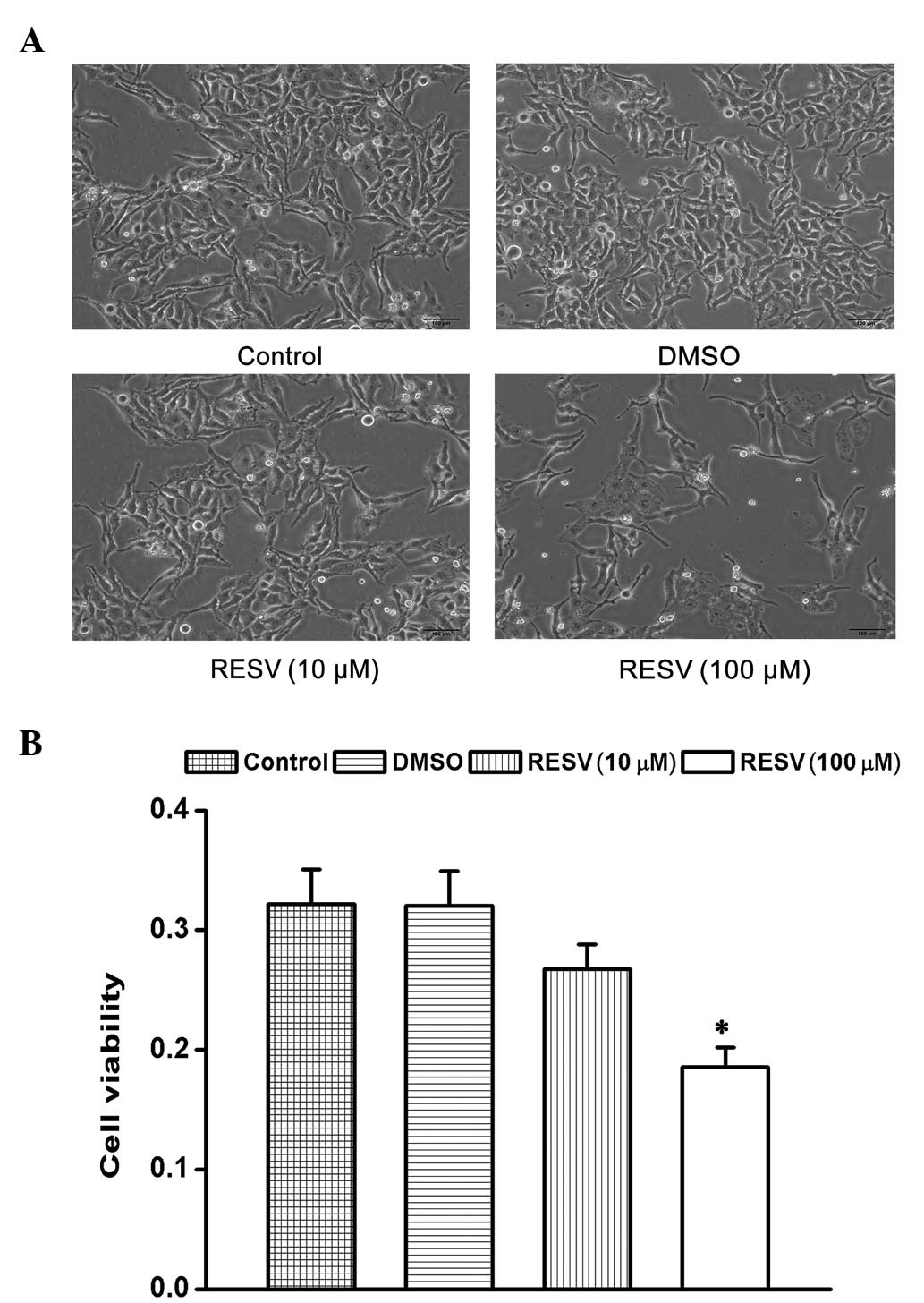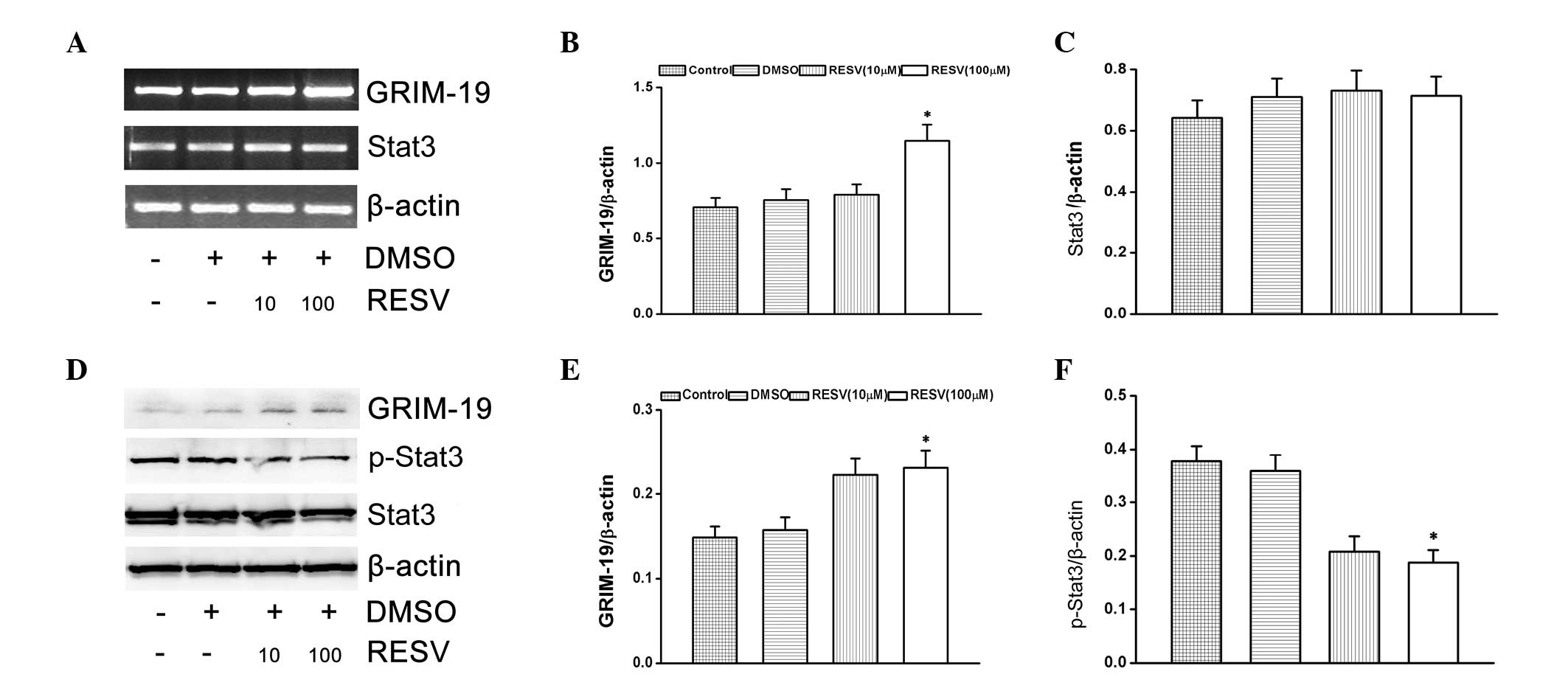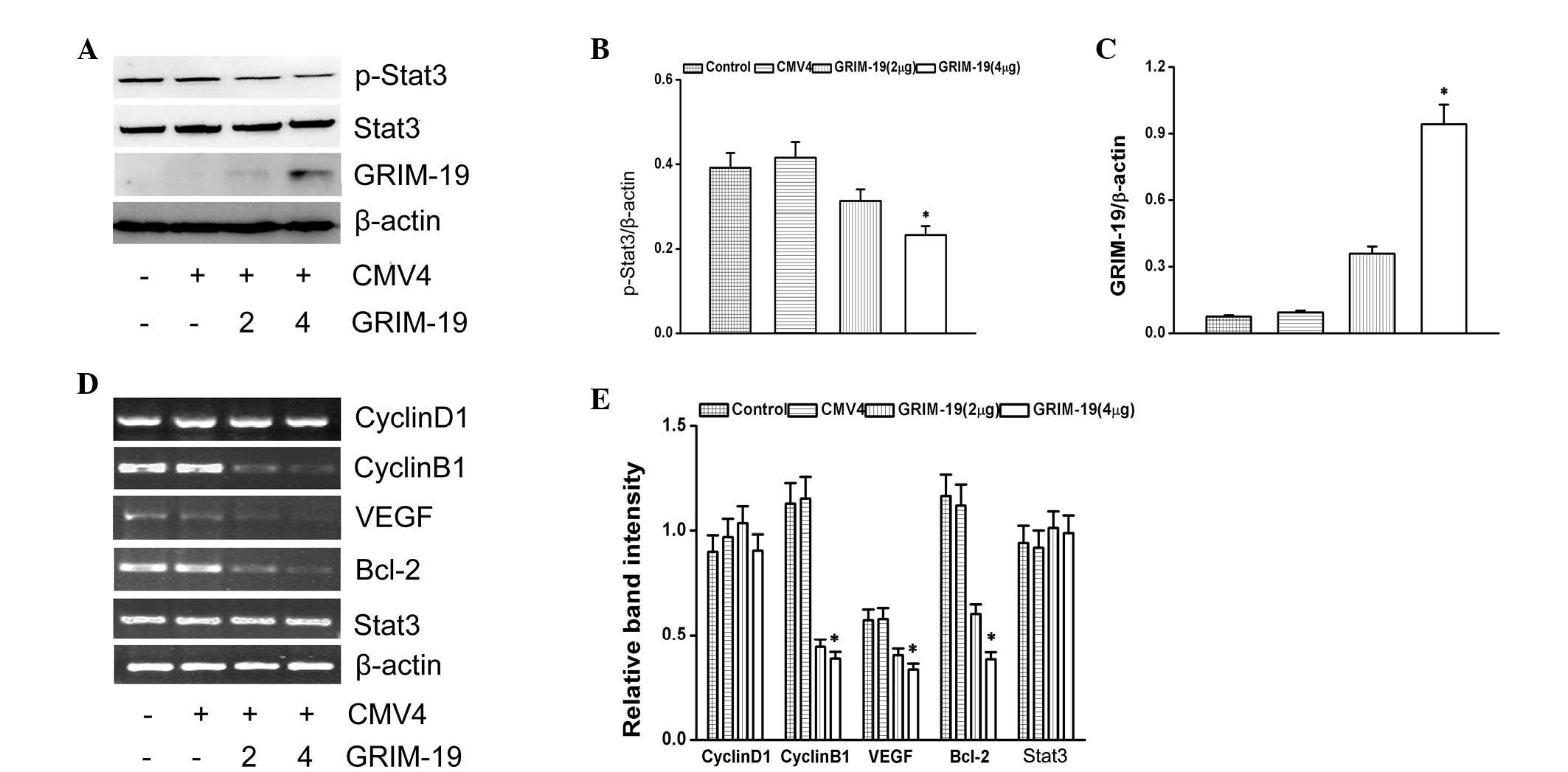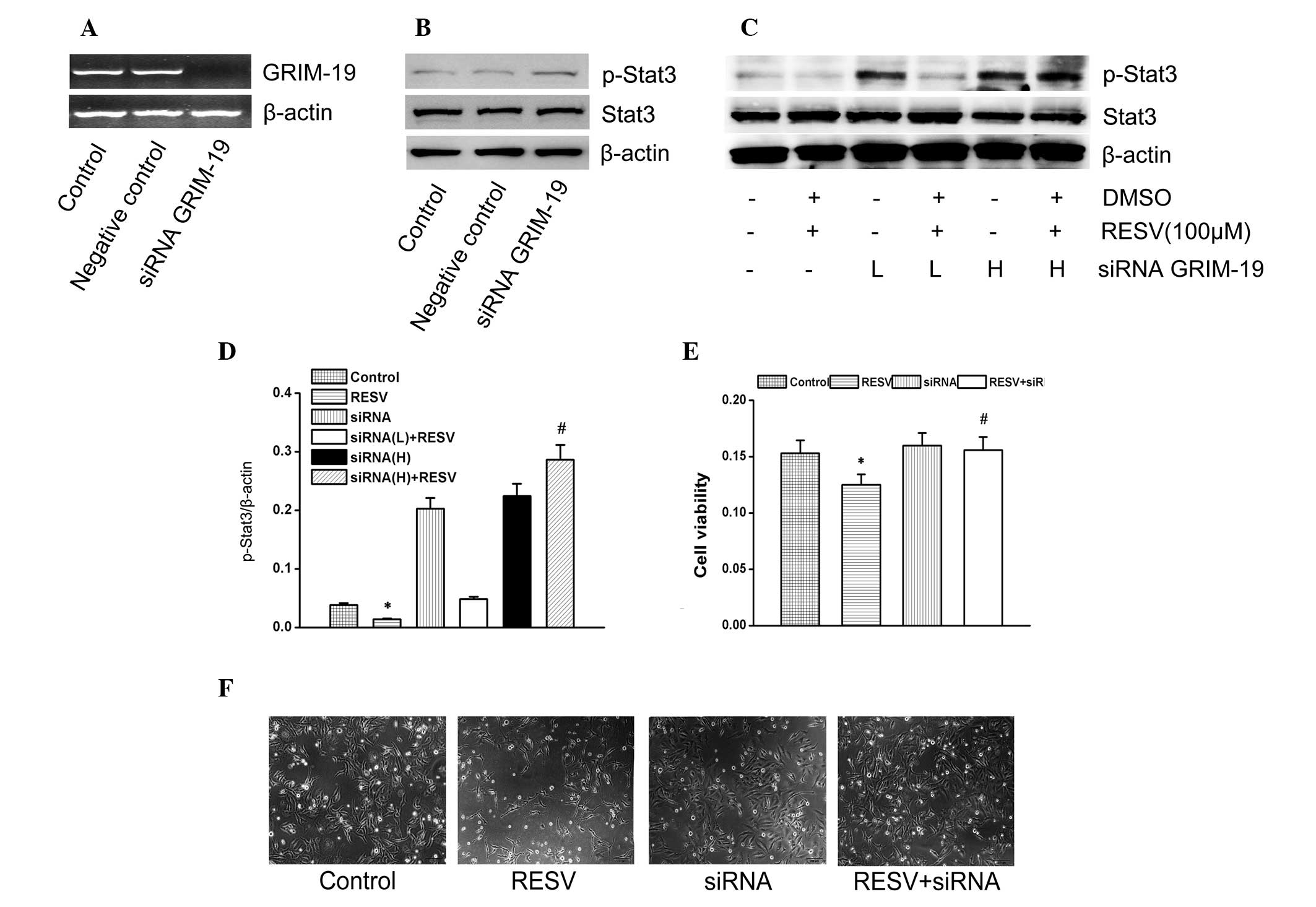GRIM‑19‑mediated Stat3 activation is a determinant for resveratrol‑induced proliferation and cytotoxicity in cervical tumor‑derived cell lines
- Authors:
- Published online on: October 29, 2014 https://doi.org/10.3892/mmr.2014.2797
- Pages: 1272-1277
Abstract
Introduction
Resveratrol is a naturally occurring phytoalexin, abundant in red grapes, which possesses antioxidant and anti-inflammatory properties. Previous studies have demonstrated that resveratrol in association with the consumption of red wine exhibits cardioprotective effects (1). In addition, several studies have demonstrated that resveratrol is important in the prevention of skin cancer (2), human breast cancer (3), oral squamous cell carcinoma (4) and the inhibition of angiogenesis (5), thereby suggesting that resveratrol has anticancer properties. However, the molecular mechanisms underlying the biological effects conferred by resveratrol have not been fully defined.
The signal transducer and activator of transcription (STAT) family is important in cells and is able to promote cell proliferation and other biological processes, which can be triggered by cytokines or growth factors (6,7). STAT is activated by phosphorylation of a critical tyrosine residue, which then forms dimers between two phosphorylated STAT monomers. Following this, the dimers are translocated into the nucleus where STAT regulates the expression of its target genes. Within the STAT family, Stat3 is constitutively activated in diverse types of human tumor. Constitutively active Stat3 is able to induce oncogenic processes, growth, survival and angiogenesis (8–10), while the suppression of phosphorylated Stat3 (p-Stat3) induces the suppression of tumor growth and apoptosis (11,12). Previous studies have demonstrated that p-Stat3 is able to be downregulated by gene associated with retinoid-IFN-induced mortality 19 (GRIM-19) (13,14).
Several studies have reported that the GRIM-19 protein can interact with the Stat3 signaling pathway. GRIM-19 has become a novel anticancer target in cancer cells that have constitutively active Stat3 (15,16). Given that GRIM-19 and Stat3 are present and active in many types of human tumor (17–19), there is considerable potential for resveratrol to modulate signal transduction pathways involved in tumor progression. The present study investigated t(he effects of resveratrol on GRIM-19-Stat3 signaling in HeLa cells, which were derived from a cervical tumor.
Materials and methods
Cell lines, reagents and treatment conditions
The HeLa cell line was obtained from the American Type Culture Collection (Manassas, VA, USA). Resveratrol and 3-(4,5-dimethylthiazol-2-yl)-2,5-diphenyltetrazolium bromide (MTT) were purchased from Sigma (St. Louis, MO, USA). Antibodies against Stat3 and p-Stat3 (phosphorylated at tyrosine 705) were purchased from Cell Signaling Technology (Beverly, MA, USA). Antibodies against β-actin were purchased from Santa Cruz Biotechnology, Inc. (Santa Cruz, CA, USA). Antibodies against GRIM-19 were purchased from eBioscience (San Diego, CA, USA). Secondary antibodies were purchased from Beijing Biosynthesis Biotechnology Co., Ltd. (Beijing, China). Penicillin, streptomycin, Dulbecco’s modified Eagle’s medium (DMEM) and fetal bovine serum (FBS) were obtained from Gibco-BRL (Grand Island, NY, USA). HeLa cells were grown in DMEM supplemented with 10% heat-inactivated FBS, 100 U/ml penicillin and 100 mg/ml streptomycin for 48 h at 37°C/5% CO2. The HeLa cells were divided into experimental groups and each treatment condition was a single dose of resveratrol at the indicated concentration. The vehicle control was 0.1% dimethyl sulfoxide (DMSO).
Western blot analysis
Western blotting was used to analyze the expression levels of p-Stat3, Stat3, GRIM-19 and β-actin. The cells were lysed with RIPA buffer (50 mM Tris-HCl pH 7.4, 150 mM NaCl, 1% sodium deoxycholate, 1% NP-40, 1 mM phenylmethylsulfonyl fluoride and 1 mM EDTA) for 45 min at 4°C. Approximately 30 μg of total protein was loaded into each lane of 10 and 15% polyacrylamide gels and subjected to sodium dodecyl sulfate polyacrylamide gel electrophoresis. The proteins were then transferred onto nitrocellulose membranes (Novex; Invitrogen Life Technologies, Carlsbad, CA, USA) and the blots were blocked in 5% (w/v) non-fat milk for 1 h at room temperature. The blots were incubated with the appropriate primary antibodies overnight at 4°C (GRIM-19 polyclonal mouse, 1:1,000 dilution; p-Stat3 monoclonal rabbit, 1:2,000; Stat3 monoclonal rabbit, 1:2,000; and β-actin polyclonal mouse, 1:3,000). The blots were washed three times for 5 min per wash and exposed to horseradish peroxidase-conjugated secondary antibodies (Biosynthesis Biotechnology Co., Ltd.) for 2 h. The blots were then examined using enhanced chemiluminescence reagent (Thermo Fisher Scientific, Waltham, MA, USA) and the band intensities were measured and quantified using Quantity One software (Bio-Rad, Hercules, CA, USA).
Reverse-transcription polymerase chain reaction (RT-PCR) assays
Total RNA was isolated from HeLa cells using TRIzol® reagent (Life Technologies, Rockville, MD, USA) following 24 h treatment with resveratrol or 48 h after transfection with GRIM-19 or a GRIM-19 short interfering RNA (siRNA). cDNA was generated from 1 μg of total RNA using a cDNA synthesis kit (Takara Biotechnology Co., Ltd., Dalian, Lianning, China) according to the manufacturer’s instructions. Primer sequences (GeneCore, Shanghai, China) specific for cyclin B1, cyclin D1, B-cell lymphoma 2 (Bcl-2), vascular endothelial growth factor (VEGF), Stat3 and GRIM-19 were used (Table I). β-actin was used for normalization of the cDNA input levels. Following cDNA synthesis, the PCR thermal cycling profile comprised 32 cycles of denaturation (95°C for 30 sec), annealing (56°C for 30 sec) and extension (72°C for 30 sec). The reaction was terminated with a final extension step (72°C for 5 min) following 32 cycles. The amplicons were separated by electrophoresis on 2% (w/v) agarose gel and visualized by staining with ethidium bromide. Three biological replicates were analyzed for each sample point and at least three reactions were used to calculate the expression levels. Relative expression was quantified using densitometry and the Gel Image Version 3.74 System (Tianon, Shanghai, China).
Transient RNA interference and transfections
GRIM-19 was knocked down using small siRNAs, with a non-targeting siRNA used in parallel as a negative control (GenePharma Co., Shanghai, China). Primary cultures were transfected with a GRIM-19 siRNA or an irrelevant siRNA (as a control) using the X-tremeGENE HP DNA transfection reagent (Roche Diagnostics GmbH, Mannheim, Germany). After 2 days, the protein expression levels of GRIM-19, p-Stat3, Stat3 and β-actin in HeLa cells were analyzed.
Plasmid construction and DNA transfection
The human GRIM-19 sequence was amplified from HeLa cells using RT-PCR and cloned between the NotI and EcoRV sites of the Pflag-CMV™-4 mammalian expression vector. The pFLAG tag was added to the N-terminus of the GRIM-19 sequences in all the constructs. The transfection of plasmids into the cells was conducted using X-tremeGENE HP DNA transfection reagent according to the manufacturer’s instructions. Following 2 days, the protein expression of GRIM-19, p-Stat3, Stat3 and β-actin in HeLa cells was analyzed.
Cell viability assay
Cell viability was determined using MTT assays according to the manufacturer’s instructions. HeLa cells were seeded in 96-well culture plates at an optimal density of 1×104 cells/well. Briefly, phosphate-buffered saline containing MTT at a final concentration of 0.5 mg/ml was added to each well following treatment with resveratrol for 24 h, and then incubated at 37°C for 4 h. The medium was gently aspirated and 150 μl DMSO was added to each well. The plates were agitated for 10 min on a shaker to dissolve the formazan product. A well containing DMSO without cells was used as a blank control and the optical density at 490 nm in each well was determined using a spectrophotometer (BioTek Instruments Inc., Winooski, VT, USA).
Statistical analysis
The data were expressed as the mean ± standard deviation for three or more independent experiments. Statistical significance was estimated using one-way analysis of variance followed by the Student-Newman-Keuls test for comparison of several groups. P<0.05 was considered to indicate a statistically significant difference.
Results
Effect of resveratrol on the proliferation and viability of HeLa cells
The present study examined the effects of resveratrol on the proliferation and cell viability of HeLa cells. Analyses by MTT assays demonstrated that the treatment of HeLa cells with resveratrol (10 and 100 μM) induced cell shrinkage (Fig. 1A) and decreased cell viability in a dose-dependent manner compared with the control and DMSO groups (Fig. 1B).
Effect of resveratrol on p-Stat3 and GRIM-19
The present study investigated the effects of resveratrol on Stat3 activation and GRIM-19 expression in HeLa cells. The cells were treated with resveratrol (10 and 100 μM) for 24 h. HeLa cells treated with resveratrol significantly induced the mRNA and protein expression of GRIM-19 (Fig. 2A–E). At the same time, p-Stat3 protein expression levels were downregulated (Fig. 2F), however, Stat3 mRNA expression levels were unaltered (Fig. 2C).
Effect of GRIM-19 on p-Stat3 and Stat3-associated genes
To understand the function of GRIM-19 on the Stat3 signaling pathway, GRIM-19 with a FLAG tag was overexpressed. The levels of p-Stat3 were decreased by the overexpression of GRIM-19 (Fig. 3A). The relative expression level of p-Stat3 is shown as ratio to β-actin (Fig. 3B). The expression of GRIM-19 is shown in Fig. 3C. Stat3-associated genes (cyclin B1, VEGF and Bcl-2) were downregulated by the overexpression of GRIM-19. However, GRIM-19 had no effect on the transcription levels of cyclin D1 (Fig. 3D).
GRIM-19 affects the function of resveratrol on the Stat3 signaling pathway
The cells transfected with GRIM-19 siRNA clearly downregulated the cell cytotoxicity induced by resveratrol (Fig. 4F). Furthermore, the expression of GRIM-19, p-Stat3 and Stat3 was detected (Fig. 4A–C). Resveratrol downregulated p-Stat3 expression, while transfection with GRIM-19 siRNA resulted in the suppression of p-Stat3 downregulation induced by resveratrol (Fig. 4C and D). The results confirmed that GRIM-19 expression, induced by resveratrol, is involved in p-Stat3 suppression induced by resveratrol. GRIM-19 was also involved in the proliferation and cytotoxicity induced by resveratrol in HeLa cells.
Discussion
Findings of previous studies have provided new insights into the biological mechanisms of resveratrol and its associated stilbene compounds have also been investigated (20). To the best of our knowledge, the present study has demonstrated for the first time that resveratrol is able to induce the expression of GRIM-19. GRIM-19 is important in the function of resveratrol on the Stat3 signaling pathway. As previously indicated, resveratrol induced a downregulation in cell viability and induced cell-cycle arrest (21,22). Furthermore, resveratrol was able to induce aberrant downstream Stat3 signaling (23,24). The results of the present study have shown that resveratrol downregulated cell viability and inhibited p-Stat3 in HeLa cells.
Stat3 is important in cancer development. STAT family members are phosphorylated by receptor-associated kinases in response to cytokines or growth factors. The phosphorylated STATs then translocate to the cell nucleus where they act as transcription activators and regulate the expression of target genes. Previous studies have demonstrated that Stat3 has an oncogenic function and that chronic Stat3 activation is important in gastric cancer (25). Increased Stat3 activity is able to upregulate the survival signal in cancer cells (26) and specific inhibition of Stat3 is a potentially useful therapy against various types of cancer (27). The present study found that resveratrol suppressed the expression of p-Stat3 and inhibited the proliferation of cancer cells. These results suggest that resveratrol suppresses HeLa cell proliferation and survival, and the anticancer function of resveratrol is partially dependent on the inhibition of Stat3 activation.
The overexpression of GRIM-19 downregulates p-Stat3 levels. At the same time GRIM-19 suppresses the transcription levels of cyclin B1, VEGF and Bcl-2. These are all downstream genes associated with cell proliferation and survival (13,14). Although the function of GRIM-19 in several types of cancer and the Stat3 signaling pathway have been previously reported (15,19), the effect of GRIM-19 on the function of resveratrol and its association with the Stat3 signaling pathway remains to be elucidated. The results from the present study clearly demonstrate that resveratrol induced the expression of GRIM-19 and suppressed the expression of p-Stat3. The GRIM-19 siRNA inhibited the suppressive effects of resveratrol on the Stat3 signaling pathway, while upregulating cell survival compared with the resveratrol group. The association between resveratrol and the Stat3 signaling pathway remains to be elucidated. However, there is a clear correlation between the role of Stat3 in cancer development (8,9) and the function of resveratrol (28,29). To the best of our knowledge, the present study has reported for the first time that resveratrol induced the expression of GRIM-19, and that GRIM-19 is important in the effects of resveratrol on HeLa cells via the abrogation of Stat3 signaling and further investigation is required in other types of cancer. In the present study, resveratrol at a high concentration (100 μM) suppressed the proliferation of HeLa cells and the Stat3 signaling pathway. Previous studies have also demonstrated that resveratrol has an effect on the src-Stat3 signaling pathway (22) and on tumor development (4). These results, in association with the results from the present study, elucidate the importance of resveratrol and its antitumor cell activities, which are partially dependent on the concentration of resveratrol (30–33).
In conclusion, the present study has reported that GRIM-19 expression, induced by resveratrol, affects the Stat3 signaling pathway. Modulation of this signal transduction pathway contributes to the resveratrol-induced biological effects on various types of cancer (34). The present study highlights a new mechanism through which resveratrol inhibits the Stat3 signaling pathway. However, further investigation is required in order to fully elucidate the anti-tumorigenic effects of resveratrol.
Acknowledgements
The present study was supported by the National Natural Science Foundation of China (nos. 81070110 to M. Wei and 81100099 to P. Xin) and the Shanghai Science and Technology Innovation Research Program (no. 11410701900 to M. Wei).
Abbreviations:
|
DMSO |
dimethyl sulfoxide |
|
DMEM |
Dulbecco’s modified Eagle’s medium |
|
GRIM-19 |
gene associated with retinoid- IFN-induced mortality 19 |
|
MTT |
3-(4,5-dimethylthiazol-2-yl)- 2,5-diphenyltetrazolium bromide |
|
Stat3 |
signal transducer and activator of transcription 3 |
|
FBS |
fetal bovine serum |
References
|
Kopp P: Resveratrol, a phytoestrogen found in red wine. A possible explanation for the conundrum of the ‘French paradox’? Eur J Endocrinol. 138:619–620. 1998. View Article : Google Scholar : PubMed/NCBI | |
|
Jang M, Cai L, Udeani GO, et al: Cancer chemopreventive activity of resveratrol, a natural product derived from grapes. Science. 275:218–220. 1997. View Article : Google Scholar : PubMed/NCBI | |
|
Mgbonyebi OP, Russo J, Russo IH, et al: Antiproliferative effect of synthetic resveratrol on human breast epithelial cells. Int J Oncol. 12:865–869. 1998.PubMed/NCBI | |
|
Elattar TM and Virji AS: The effect of red wine and its components on growth and proliferation of human oral squamous carcinoma cells. Anticancer Res. 19:5407–5414. 1999. | |
|
Srivastava RK, Unterman TG and Shankar S: FOXO transcription factors and VEGF neutralizing antibody enhance antiangiogenic effects of resveratrol. Mol Cell Biochem. 337:201–212. 2010. View Article : Google Scholar | |
|
Bromberg J and Darnell JE Jr: The role of STATs in transcriptional control and their impact on cellular function. Oncogene. 19:2468–2473. 2000. View Article : Google Scholar : PubMed/NCBI | |
|
Yu H and Jove R: The STATs of cancer - new molecular targets come of age. Nat Rev Cancer. 4:97–105. 2004. View Article : Google Scholar : PubMed/NCBI | |
|
Macias E, Rao D and Digiovanni J: Role of stat3 in skin carcinogenesis: insights gained from relevant mouse models. J Skin Cancer. 2013:6840502013. View Article : Google Scholar : PubMed/NCBI | |
|
Cho KH, Jeong KJ, Shin SC, et al: STAT3 mediates TGF-beta1-induced TWIST1 expression and prostate cancer invasion. Cancer Lett. 336:167–173. 2013. View Article : Google Scholar : PubMed/NCBI | |
|
You W, Tang Q, Zhang C, et al: IL-26 promotes the proliferation and survival of human gastric cancer cells by regulating the balance of STAT1 and STAT3 activation. PLoS One. 8:e635882013. View Article : Google Scholar : PubMed/NCBI | |
|
Han Z, Feng J, Hong Z, et al: Silencing of the STAT3 signaling pathway reverses the inherent and induced chemoresistance of human ovarian cancer cells. Biochem Biophys Res Commun. 435:188–194. 2013. View Article : Google Scholar : PubMed/NCBI | |
|
Yu W, Xiao H, Lin J and Li C: Discovery of novel STAT3 small molecule inhibitors via in silico site-directed fragment-based drug design. J Med Chem. 56:4402–4412. 2013. View Article : Google Scholar : PubMed/NCBI | |
|
Okamoto T, Inozume T, Mitsui H, et al: Overexpression of GRIM-19 in cancer cells suppresses STAT3-mediated signal transduction and cancer growth. Mol Cancer Ther. 9:2333–2343. 2010. View Article : Google Scholar : PubMed/NCBI | |
|
Nallar SC, Kalakonda S, Lindner DJ, et al: Tumor-derived mutations in the gene associated with retinoid interferon-induced mortality (GRIM-19) disrupt its anti-signal transducer and activator of transcription 3 (STAT3) activity and promote oncogenesis. J Biol Chem. 288:7930–7941. 2013. View Article : Google Scholar : PubMed/NCBI | |
|
Bu X, Zhao C, Wang W and Zhang N: GRIM-19 inhibits the STAT3 signaling pathway and sensitizes gastric cancer cells to radiation. Gene. 512:198–205. 2013. View Article : Google Scholar | |
|
Lufei C, Ma J, Huang G, et al: GRIM-19, a death-regulatory gene product, suppresses Stat3 activity via functional interaction. Embo J. 22:1325–1335. 2003. View Article : Google Scholar : PubMed/NCBI | |
|
Zhou T, Chao L, Rong G, et al: Down-regulation of GRIM-19 is associated with STAT3 overexpression in breast carcinomas. Hum Pathol. 44:1773–1779. 2013. View Article : Google Scholar : PubMed/NCBI | |
|
Nallar SC, Kalakonda S, Sun P, et al: Identification of a structural motif in the tumor-suppressive protein GRIM-19 required for its antitumor activity. Am J Pathol. 177:896–907. 2010. View Article : Google Scholar : PubMed/NCBI | |
|
Zhang Y, Hao H, Zhao S, et al: Downregulation of GRIM-19 promotes growth and migration of human glioma cells. Cancer Sci. 102:1991–1999. 2011. View Article : Google Scholar : PubMed/NCBI | |
|
Robertson CN, Roberson KM, Padilla GM, et al: Induction of apoptosis by diethylstilbestrol in hormone-insensitive prostate cancer cells. J Natl Cancer Inst. 88:908–917. 1996. View Article : Google Scholar : PubMed/NCBI | |
|
Wen S, Li H, Wu ML, et al: Inhibition of NF-kappaB signaling commits resveratrol-treated medulloblastoma cells to apoptosis without neuronal differentiation. J Neurooncol. 104:169–177. 2011. View Article : Google Scholar | |
|
Kotha A, Sekharam M, Cilenti L, et al: Resveratrol inhibits Src and Stat3 signaling and induces the apoptosis of malignant cells containing activated Stat3 protein. Mol Cancer Ther. 5:621–629. 2006. View Article : Google Scholar : PubMed/NCBI | |
|
Capiralla H, Vingtdeux V, Zhao H, et al: Resveratrol mitigates lipopolysaccharide- and Abeta-mediated microglial inflammation by inhibiting the TLR4/NF-kappaB/STAT signaling cascade. J Neurochem. 120:461–472. 2012. View Article : Google Scholar : | |
|
Scuto A, Kirschbaum M, Buettner R, et al: SIRT1 activation enhances HDAC inhibition-mediated upregulation of GADD45G by repressing the binding of NF-kappaB/STAT3 complex to its promoter in malignant lymphoid cells. Cell Death Dis. 4:e6352013. View Article : Google Scholar | |
|
Giraud AS, Menheniott TR and Judd LM: Targeting STAT3 in gastric cancer. Expert Opin Ther Targets. 16:889–901. 2012. View Article : Google Scholar : PubMed/NCBI | |
|
Deng J, Liu Y, Lee H, et al: S1PR1-STAT3 signaling is crucial for myeloid cell colonization at future metastatic sites. Cancer Cell. 21:642–654. 2012. View Article : Google Scholar : PubMed/NCBI | |
|
Tkach M, Coria L, Rosemblit C, et al: Targeting Stat3 induces senescence in tumor cells and elicits prophylactic and therapeutic immune responses against breast cancer growth mediated by NK cells and CD4+ T cells. J Immunol. 189:1162–1172. 2012. View Article : Google Scholar : PubMed/NCBI | |
|
Sheth S, Jajoo S, Kaur T, et al: Resveratrol reduces prostate cancer growth and metastasis by inhibiting the Akt/MicroRNA-21 pathway. PLoS One. 7:e516552012. View Article : Google Scholar : PubMed/NCBI | |
|
Wang H, Zhang H, Tang L, et al: Resveratrol inhibits TGF-beta1-induced epithelial-to-mesenchymal transition and suppresses lung cancer invasion and metastasis. Toxicology. 303:139–146. 2013. View Article : Google Scholar | |
|
Aziz MH, Kumar R and Ahmad N: Cancer chemoprevention by resveratrol: In vitro and in vivo studies and the underlying mechanisms (Review). Int J Oncol. 23:17–28. 2003.PubMed/NCBI | |
|
Jeong WS, Kim IW, Hu R and Kong AN: Modulation of AP-1 by natural chemopreventive compounds in human colon HT-29 cancer cell line. Pharm Res. 21:649–660. 2004. View Article : Google Scholar : PubMed/NCBI | |
|
Wu Y and Liu F: Targeting mTOR: Evaluating the therapeutic potential of resveratrol for cancer treatment. Anticancer Agents Med Chem. 13:1032–1038. 2013. View Article : Google Scholar : PubMed/NCBI | |
|
Chung MY, Lim TG and Lee KW: Molecular mechanisms of chemopreventive phytochemicals against gastroenterological cancer development. World J Gastroenterol. 19:984–993. 2013. View Article : Google Scholar : PubMed/NCBI | |
|
Kong AN, Yu R, Hebbar V, et al: Signal transduction events elicited by cancer prevention compounds. Mutat Res. 480–481:231–241. 2001. View Article : Google Scholar |













